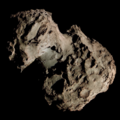 Comet Kiess photographed by Ferdinand Quénisset from the Flammarion Observatory on 29 July 1911 | |
| Discovery | |
|---|---|
| Discovered by | Carl Clarence Kiess |
| Discovery site | Lick Observatory |
| Discovery date | 6 July 1911 |
| Designations | |
| 1911 II, 1911b [1] | |
| Orbital characteristics [2] | |
| Epoch | 30 July 1911 (JD 2419247.5) |
| Observation arc | 71 days |
| Number of observations | 86 |
| Aphelion | 366 AU |
| Perihelion | 0.684 AU |
| Semi-major axis | 184 AU |
| Eccentricity | 0.9963 |
| Orbital period | 2490±125 years ≈2067 years (barycentric) [3] |
| Inclination | 148.42° |
| 158.67° | |
| Argument of periapsis | 110.37° |
| Last perihelion | 30 June 1911 |
| TJupiter | -0.844 |
| Earth MOID | 0.003 AU |
| Physical characteristics [4] [5] | |
Mean radius | 0.867 km (0.539 mi) [a] |
| Comet total magnitude (M1) | 7.4 |
| 5.0 (1911 apparition) | |
C/1911 N1 (Kiess) is a non-periodic comet discovered by Carl Clarence Kiess on 6 July 1911. The comet has been identified as the parent body of the Aurigids meteor shower.



